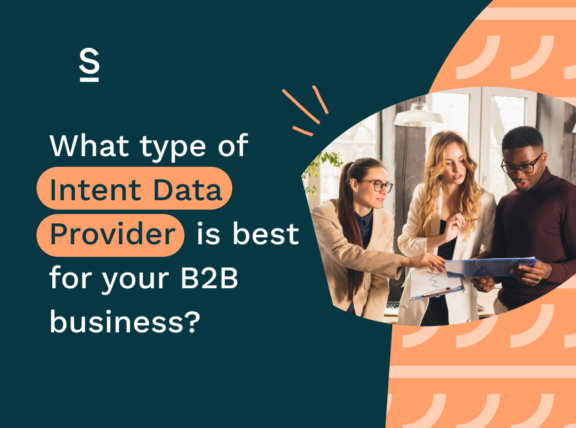How to measure the ROI of Buyer Intent Data Investments

The ability to leverage data effectively can make the difference between thriving and just surviving. One of the most significant advancements in data-driven sales is significant ROI of buyer intent data.
As companies increasingly rely on digital footprints to predict customer behavior, intent data has emerged as a pivotal resource. This type of data not only clues businesses into when a prospect might be ready to buy but also illuminates the ‘why’ behind their decisions, offering a direct line into their purchase intentions.
By understanding the specific interests and behaviors of potential customers, businesses can tailor their approaches to meet the precise needs of their target audiences, thereby increasing efficiency and effectiveness.
In this article, we will delve into how businesses can effectively measure the ROI of buyer intent data investments. We will explore the metrics that matter, the calculations that count, and the strategies that showcase the true ROI of buyer intent data in transforming potential leads into profitable engagements. By the end of this discussion, you will have a clearer understanding of how to leverage intent data not just as information, but as a significant business asset that drives decision-making and fuels growth.
Key Takeaways:
- What is the goal of using buyer intent data?
- Measure Customer Acquisition Costs (CAC)
- What is Buyer Intent Data worth to you?
ROI of Buyer Intent
=
(Profit from using buyer intent/Cost of buyer intent)

Understanding the Value of Intent Data
Intent data represents digital breadcrumbs left by potential customers as they navigate the internet. This data is collected from a variety of sources including web page visits, downloads, and search queries. It offers a detailed insight into the intentions of prospects, revealing what they are interested in and how close they might be to making a purchase decision.
Relevance to Modern Businesses
For modern businesses operating in an increasingly digital landscape, intent data is invaluable. It serves as a compass, guiding companies to those who show a genuine interest in their products or services. By harnessing the ROI of buyer intent data, businesses can:
Predict Purchasing Behavior
Anticipate when a prospect is likely to make a purchase based on their online activities.
Enhance Customer Profiles
Enrich customer databases with nuanced data, allowing for more targeted marketing and sales strategies.
Increase Market Agility
Quickly adapt marketing and sales strategies in response to real-time customer interest data.
Impact on Sales
The strategic application of intent data significantly boosts the effectiveness of sales efforts in several ways:
Personalization
Businesses can customize their communication and offerings to align with the specific needs and interests of potential buyers. This personalized approach not only improves customer engagement but also enhances the overall customer experience.
Improved Lead Generation
Intent data allows for more precise targeting, which leads to generating higher-quality leads. Sales teams can prioritize their efforts on leads that have shown a clear interest in similar products or services, thus increasing the likelihood of conversion.
Driving Sales
With insights about where a prospect is in the buying cycle, sales teams can time their outreach perfectly. This timely engagement increases the chances of closing deals by connecting with potential customers at the moment they are most receptive to making a purchase.
In essence, the ROI of buyer intent data equips businesses with the tools needed to not just reach their audience, but to connect with them in a meaningful way that drives engagement and, ultimately, sales. This tailored approach is not just about selling more, it’s about selling smarter.

Wondering how the ROI of buyer intent varies across providers?
What is the goal of using buyer intent data?
Before diving into the collection and application of intent data, it is crucial for businesses to define clear and specific objectives. Setting well-defined goals at the outset not only guides the strategic use of intent data but also provides a benchmark against which to measure its effectiveness, which helps with proving ROI.
Importance of Clear Objectives
Clear objectives align all team members towards common goals and ensure that the use of intent data is purpose-driven. Without distinct objectives, businesses risk diluting their efforts across too many fronts, making it difficult to assess the effectiveness of their data-driven strategies.
These are the most important objectives you should be thinking about:
Increasing Lead Generation
Use intent data to identify and engage with potential customers who are actively seeking solutions that your business offers. By focusing on these prospects, you can increase the quantity and quality of your lead generation.
Improving Sales Conversions
Enhance the effectiveness of sales strategies by targeting prospects identified through intent data as being at a decisive stage in the buying process. Tailored messaging and timely engagement can significantly improve conversion rates.
Enhancing Targeted Sales Campaigns
Develop highly targeted sales campaigns based on the specific interests and behaviors of potential customers as revealed by intent data. This specificity allows for more personalized and relevant content, increasing the likelihood of resonating with the audience.
Measure Customer Acquisition Costs (CAC)
Customer Acquisition Cost (CAC) is a vital metric for any business investing in intent data. It quantifies the cost of acquiring a new customer through specific marketing efforts, providing a clear financial perspective on the effectiveness of these investments.
How to Calculate CAC
CAC is calculated by dividing the total costs associated with the acquisition of new customers through intent data by the number of new customers or leads generated from these efforts. The formula is:
CAC = (Number of New Customers/Total Intent Data Investment Costs)
Total Intent Data Investment Costs include all expenses related to the acquisition, management, and analysis of intent data. This covers costs for subscriptions to data providers, related software tools, and personnel involved in data-related activities.
Number of New Customers refers to those directly generated from campaigns and strategies that utilize intent data.
It’s absolutely crucial you understand CAC
Cost-Effectiveness
CAC provides a straightforward measure of how much you are spending to gain a new customer. It is a direct reflection of the efficiency and effectiveness of your marketing and sales efforts driven by intent data, and is a vital metric that can help you analyze your ROI.
Budget Allocation
By knowing the CAC, businesses can make informed decisions about budget allocation. If the CAC is high, it might indicate a need to optimize marketing strategies or perhaps to renegotiate terms with data providers.
Profitability Analysis
Comparing CAC with the Lifetime Value (LTV) of customers can reveal the long-term profitability of acquiring customers through intent data. A low CAC relative to high LTV suggests a sustainable strategy, whereas a high CAC may require strategic adjustments to ensure profitability.
Benchmarking and Optimization
CAC allows businesses to benchmark their performance against industry standards and competitors. It also serves as a baseline to measure the impact of any improvements or changes in data-driven strategies.
By regularly calculating and reviewing CAC, businesses can maintain a clear understanding of the financial impacts of their data-driven initiatives, ensuring that their investments in intent data are not only effective in driving sales but also cost-efficient. This strategic insight is essential for sustaining and scaling business operations effectively.
You when you realize the importance of buyer intent data for your sales strategy:

What is Buyer Intent Data worth to you?
When using Buyer Intent Data to acquire leads, how many leads is it going to help you acquire and what is the value of those leads?
You’ll need to calculate the Lifetime Value (LTV) of these leads so you can compare it against the costs.
Lifetime Value (LTV) is a metric used to estimate the total revenue a business can expect from a single customer throughout the duration of their relationship. It considers the overall value a customer brings to the company, not just from a single transaction, but over the entire period they continue to do business with the company.
This helps businesses understand the long-term financial benefit each customer provides, guiding decisions about how much to invest in customer acquisition and retention strategies.
Let’s Wrap It Up
Now that you have both the Customer Acquisition Cost (CAC) and the Lifetime Value (LTV), you can determine the Return on Investment (ROI) and decide if the investment in buyer intent data is financially worthwhile.
It’s important to consider the ratio of LTV to CAC. A higher LTV compared to CAC indicates a profitable investment, suggesting that the revenue generated from a customer significantly outweighs the cost of acquiring them. Regularly revisiting these metrics will help ensure that your strategies remain effective and yield positive returns.

Surfe makes your prospecting smooth
From prospection, to outreach, to conversion. Surfe makes every step more efficient.
FAQs about measuring the ROI of Buyer Intent Data Investment
What is buyer intent data?
B2B buyer intent data allows you to identify when a B2B prospect is actively considering, or looking to purchase your product or solution, enabling informed, timely campaign decisions.
How do you measure the Customer Acquisition Cost of buyer intent data investment?
You can measure CAC by adding up all the customers gained from data intent, and divide it by the total cost of your data intent investments.
Is investing buyer intent data worth it?
Many many businesses are investing in buyer intent data, but not all of them are utilizing that information to its full potential. The data is only as valuable as what you do with it, so you’d need an analyst, and a team ready to put those insights into action.


